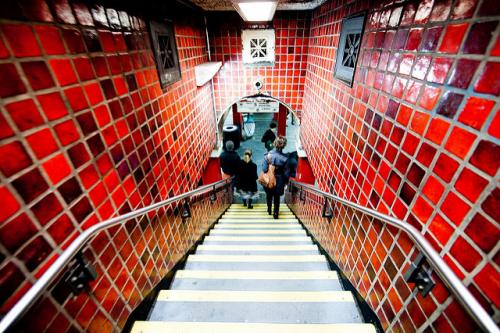Written by an association of women with backgrounds in the fields of architecture, urban planning, and sociology, a guide allowing women to participate to urban transformation in an active way
How does a gender perspective
contribute to urban planning?

Urban planning is the discipline that plans and constructs our neighborhoods, towns, and cities. It covers a wide variety of spaces that include housing, public space, facilities, transportation, and the environment. These elements are the physical support of our everyday life, and the way they are designed, as well as the locations where services are provided, directly influence our living conditions.
Traditionally, urban planning has been considered a neutral field, meaning that the way of designing different spaces neither benefited nor harmed a particular person or group. However, beginning in the 1970s, feminists have demonstrated how that’s not true. We live in an unequal society in which people have different opportunities and obligations depending on whether we are women or men, and this inequality is also reflected in the way that spaces are constructed.
Historically, spaces have been designed following and perpetuating gender roles. Because of that, public space has been linked to men, where public activities take place such as: paid work, leisure, or political life. At the same time, the private space of the home has been identified with women, where they complete domestic chores and take care of other people. The division of spaces also entails a different way to value the people and the activities that are carried out by each, attributing a higher value to masculine and public activities, and devaluing the tasks related to the care of other people and the home, for which mostly women continue to be responsible.
Although this has been the most widespread way of thinking about the world, over the decades feminism has questioned this division and has worked to make it recognized that women have always participated one way or another in the productive world (in formal and informal labor), and that reproductive responsibilities and care of other people don’t only take place inside the home, but rather that they extend outside of the “private” environment: accompanying kids to school, grocery shopping, etc.
Facing this way of simplifying the reality of traditional urban planning, urban planning from a gender perspective provides a broad vision of people by outlining that women, men and trans people live and experience space differently. Today, both assume distinct responsibilities, and this materializes daily in their relationship with the environment. Nevertheless, women continue being the ones principally responsible for tasks related to reproductive roles, care and development of the home and family, food preparation, grocery shopping, and the completion of administrative or personal obligations. In that context, urban planning from a gender perspective recognizes and makes visible the daily experience of women and the needs and responsibilities associated with domestic work and caregiving, which is to say all of the indispensable tasks for human development.
An intersectional gender perspective also keeps in mind diversity beyond sex and incorporates other characteristics that influence how people experience space differently: ethnicity, age, religion, disability, etc. As such, the focus on gender demonstrates that women and men make different use of space due to gender roles, but also that neither all women nor all men are the same among their genders because they each have other personal characteristics, like age: the needs of a 15 years-old adolescent will be different from those of a 70 years-old woman.
It’s also important to recognize that everyday life is performed in different spheres: productive (paid work), reproductive (caring for people and the home), personal (leisure, sport, and self-care), and community (improving society or the community where one lives). All should be kept in mind while planning and designing the spaces where we live.
The analysis of everyday life serves to take account of the complexity of realities and of the multiple activities that people carry out on a daily basis; this enables understanding of the diverse needs that coexist in our towns and cities. Public space, the streets, housing, transportation, and the rest of the spaces that we use regularly are the places where our lives take place, and therefore should be adjusted to the different needs that we all have as people. In this sense, it’s important to recognize women as experts when they talk about the relationship between everyday life and the city. They continue to be principally responsible for domestic work, caring for the home and people who live there, which makes them specialists in the territory and of the changing needs of people in different stages of life (childhood, youth, senior).
Women Working: Urban Assessment Guide from a Gender Perspective
Since 2005 we have been feeding our urban knowledge with the shared experiences of more than 1,000 women participating in hundreds of workshops, and within participatory diagnostic processes and design of proposals to improve the environments of their neighborhoods, in Catalonia, Spain, and Latin America.
In 2013, we decided to publish an urban assessment guide to return to women the accumulated collective knowledge, to encourage autonomy and ownership in the betterment of their neighborhoods, in a manner that can be expanded to the rest of society.
This guide aims to give visibility to women, as a unique source of knowledge and as agents for urban transformation. History has erased the contribution that women have made in the construction and transformation of our neighborhoods and settlements. Women have been excluded from decisions about urban change because traditionally this has been viewed as a masculine realm. As a consequence, much of the work which is indispensable for society has not been adequately valued: the work related to people’s wellbeing, which mainly deals with the domestic realm, community work, such as that related to the betterment of services in a neighborhood (water, waste, lighting, etc.). All these types of work are integrally linked to the place where we live, to the form of space, the way we move through them or the manner in which we interact with neighbors. This is to say, as women we possess crucial knowledge to describe the everyday life of the environments, which we inhabit and that can help transmit not only our needs and wishes but also those of our children, young people and the elderly with whom we live. Women usually have a better understanding of what goes on in their neighborhood; of the needs of their community and of the things that must be done to make it a better place. This occurs because, although we have been in the paid working world for decades, women are still the primary caretakers of the home and caregivers of others, taking on double or triple work shifts. This guide is a tool to provide visibility to the women’s experiences, but also to question the division of work and to reclaim environments where domestic and care duties are socially shared so that they stop being a responsibility exclusive to women.
We want women’s groups that wish to participate in the urban transformation and physical and social betterment of their environment to be able to use this guide in their neighborhoods, towns, or cities in which they live. This guide is also a tool to allow participatory processes in the urban realm to become transformative, where women can be active participants of the analysis and neighborhood improvements. The guide will help take advantage of the valuable work and knowledge that already exists in our neighborhoods, towns or cities. In this way, the guide should promote women’s empowerment in order to allow women participate in the urban transformation in an active manner and as real engines for change.





